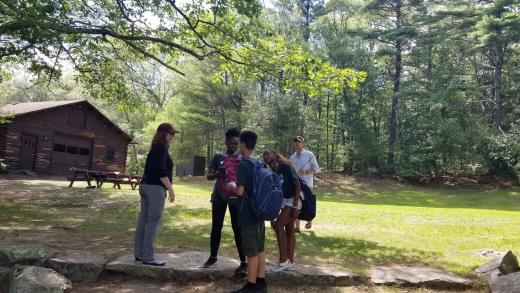Take a Kid Fishing: Tips, Tricks and Advice
Watching a young angler fall in love with fly fishing is one of the greatest joys in our sport. For some, it comes with the electric tug of her or his first fish, for others the moment they fall into the rhythm of casting or see blue heron pick its way down a bank. Whether you have children of your own or not, getting young people hooked early is essential, and a lot of fun.
Just like coaxing a wary trout to your fly, getting young people interested requires patience, determination, and creativity. We are lucky to have a bevy of skilled instructors who love working with young people here at GBTU. Below are some tips and tricks from our members on how to get kids interested, keep them interested, and instill the all-important ethic of conservation. Hit the comments to add your own unique take!
Embrace the Unknown:
I've been fishing with kids and teaching kids -- from five years old through teenagers -- to fly fish for many years.
The greatest joy is seeing them succeed at something totally unfamiliar. Yes, the smiles come from being in beautiful places, from catching a fish, but the best smiles come from the "I can do it," moment. That's a life lesson to catch-and-keep.
Ellen Smith
Be Holistic:
For many children, a parent or relative teaches them how to put a worm on a hook, catch a fish and put a memorable smile of accomplishment on their face. Once a child hits 5th grade, their kinesthetics have improved to a point where they are able to handle the nuances and challenges of more advanced techniques that come with fly fishing.
As a parent of two scouts, assistant scoutmaster and merit badge coordinator Troop 304, Belmont, MA, I am taking 10 scouts through the Fly Fishing Merit Badge process. Camping along the Deerfield River in June was the perfect time to initiate the eager scouts into this rewarding adventure. After our safety briefing, the range of initial casting skills varied and I found their degree of success was closely aligned with their athletic abilities (I coach many of these boys in youth soccer). Keeping the 11 to 1 range and letting the line unfurl was the biggest challenge, but proficiency was gained with each cast, along with lots of positive reinforcement (tell them what they are doing right, or need to do right, not what they are doing wrong). I know the magic was beginning to happen when I heard “Mr. Coelho, this is more like an art form than fishing with a worm & bobber.” It was so rewarding to see first steps in the journey of fly fishers for the next generation of conservationists.
If you have the skill and some time, think about who you can introduce into this wonderful adventure. Please consider taking your first steps by approaching your local youth, school, scout or TU organization and made a difference.
Rui Coelho
Don’t Be Afraid to Ask For Some Help:
Given my passion for fly fishing and the sheer enjoyment I get every time I do it, I’ve wondered why it didn’t take hold for me when I was a kid? When I was 10 years old, I was given a WT Grant rod and reel kit with a level fly line (yes that’s correct, a level line); it was difficult to learn to cast it and without proper instruction and a place to fly fish. I soon lost interest and it took 25 years before I was reintroduced to the sport. Here are my suggestions for introducing youngsters to fly fishing.
One, purchase the correct gear. Retailers like Orvis and LL Bean are great resources and provide reasonably priced items. Two, find a local instructor to provide casting lessons. TU is a great resource as we have many skilled casters who enjoy teaching casting as well as local outfitters who are all willing to provide both casting instruction and help with purchasing the proper rod/reel/line. And finally, make it fun. Find a local pond or stream where fly casting will produce the joy of a fish taking that fly cast by one’s son or daughter. What we did, and it has had lasting benefits, was to take our daughter for a lesson when we were vacationing. She learned to cast a fly rod and was then taken to a pond full of willing and eager trout and hooked and landed her first trout. She was ecstatic. Finally, I’ve seen how young people seem to be particularly delighted to tie a fly. There is nothing better than to cast a fly you’ve tied and had a fish take that fly – pure joy. See you on the water!
Gary Crago
Make Fun Number One:
Make sure they have fun. Catching a fish and learning to cast is secondary to kids just having fun near a body of water, which does not have to blue ribbon trout water. You may be excited about teaching the fundamentals: they may be more interested in turning over rocks, watching dragonflies whiz around, or looking for frogs. Remember also short attention spans, so look to engage and quickly.
Bill Pastuszek


